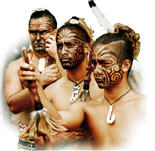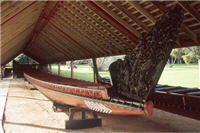
My good friends from 'down-under' - Holona & Trish Lui
New Zealand’s nationhood is both proudly acknowledged and embraced on Waitangi Day: the 6thof February. It marks the signing of the Treaty of Waitangi in 1840 between the local Maori (NZ indigenous people) and the British Crown. Over the years the Treaty has been hailed and celebrated as a symbol of New Zealand’s nationhood; but, on the other hand, the Treaty is also condemned by those who seek to ignore and dismiss its provisions and obligations on the Crown to safeguard Maori rights to their language, culture, land and resources. This has meant that Waitangi Day is both a celebration of nationhood, and at times a flash point between the differing cultural values of Maori…
Read more.. »



 of the world’s largest Māori ceremonial waka (war canoe), the Ngatokimatawhaorua, can be found at Waitangi. The enormous wooden vessel, with room for 80 paddlers and 55 passengers, is an impressive sight on the water. The 70-year-old waka has been refurbished and relaunched for the 2010 celebrations. See
of the world’s largest Māori ceremonial waka (war canoe), the Ngatokimatawhaorua, can be found at Waitangi. The enormous wooden vessel, with room for 80 paddlers and 55 passengers, is an impressive sight on the water. The 70-year-old waka has been refurbished and relaunched for the 2010 celebrations. See  Hello, I'm Deborah Swallow and, for the last fifteen years, I've worked in over thirty countries addressing the complexities of people working internationally across multiple cultures, so individuals and organisations alike can gain an authentic competitive edge and win in international markets.
Hello, I'm Deborah Swallow and, for the last fifteen years, I've worked in over thirty countries addressing the complexities of people working internationally across multiple cultures, so individuals and organisations alike can gain an authentic competitive edge and win in international markets. 